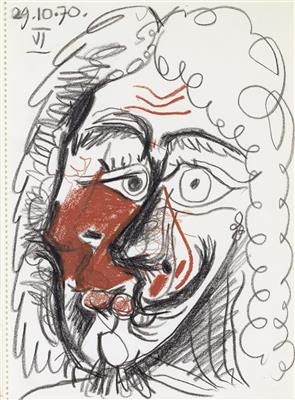Pablo Picasso *

(Malaga 1881–1973 Mougins)
Tête d’homme, dated, numbered 29.10.70 VI, wax crayon of thick paper (with punched hole border to left), 37.2 x 27 cm, framed, (PS)
Certificate:
Claude Picasso, Paris 8.2.2006; Maya Picasso, Paris, 3.4.2005
Provenance:
Collection Francois Lachenal (1918-1997), Paris
Private Collection
Christie’s London, 23.6.2005, lot 308
Private Collection, France
Picasso used drawings as an aid in the preparation and execution of his paintings. Drawing was his approach to new and different forms, dissecting a subject in order to intensify it by means of numerous repetitions on freely available structures. The formal representation of faces, which he used repeatedly in ever new variations, thus came to bear a special significance in Picasso’s work. ‘He neither deleted nor erased; he recorded shapes and objects in quick sketches, holding onto innumerable shapes and movements on paper, almost more than memory alone could capture.’
(Zervos 1949, quoted in Spies, Werner, Picasso: Pastelle, Zeichnungen, Aquarelle. Stuttgart: published by Gerd Hatje, 1986, p.46)
Using rapid, short strokes he modified the suggested shape of the face to a level of free association, varying the facial features in frontal and profile views as if they were chance finds and odds and ends, seemingly pushing over each other whilst simultaneously being thwarted by the brown colouring. The change from frontal to profile view, and the suggestion of the positive as a negative form, effectively describes movement to the face.
He modelled unmistakable, unforgettable faces by capturing the unfamiliar and fixing character of the look. Char interpreted the different eyes as an allegory of life; the left eye is ‘completely normal, while the right eye is a solid black circle. However, this signifies neither blindness, nor a variation in strength of vision. It is the distinction between day and night. It is life.’
(Char, René. 1976. Picasso under the Etesian Winds. Picasso in Perspective. pp. 168-171. Ed. by Gert Schiff; Preface to the exhibition catalogue Picasso 1970-1972, 201 peintures, du 23 mai au 23 septembre 1973. Englewood Cliffs, N.J.; Prentice-Hall. p.171)
There are few clues as to the identity of the man portrayed here. On the figurative, meticulously detailed level, the viewer registers eyes which lend presence to the face shown here, and a radiant life-force. In addition, pronounced facial features with eyebrows, a moustache, a striking nose and long wavy hair suggest two-dimensional indications of volume. In spite of these fragments, the appearance remains a puzzle, both alarming and fascinating: the hairstyle, twirled moustache and the suggestion of a ruff can only be identified when compared with depictions of musketeers, models of which Picasso studied in the works of the Old Masters, including El Greco, Rembrandt and Velasquez. Although offering a modern interpretation, the portrayal invokes fashions of Regency period, the Spanish upper classes and 17th century Holland.
Christian Zervos, when presenting a selection of Picasso’s drawings in 1949, noted: ‘It is difficult to imagine a single individual with such a strong desire to try out so many different artistic ideas, and who uses so many ways to satisfy this desire. Picasso was far more interested in the experiments he carried out than in their promised outcomes.’
(Zervos 1949, quoted in Spies, Werner, Picasso: Pastelle, Zeichnungen, Aquarelle. Stuttgart: published by Gerd Hatje, 1986, p.45)
Expert: Dr. Petra Maria Schäpers
 Dr. Petra Maria Schäpers
Dr. Petra Maria Schäpers
+49 211 2107747
petra.schaepers@dorotheum.de
09.06.2015 - 19:00
- Odhadní cena:
-
EUR 200.000,- do EUR 250.000,-
Pablo Picasso *
(Malaga 1881–1973 Mougins)
Tête d’homme, dated, numbered 29.10.70 VI, wax crayon of thick paper (with punched hole border to left), 37.2 x 27 cm, framed, (PS)
Certificate:
Claude Picasso, Paris 8.2.2006; Maya Picasso, Paris, 3.4.2005
Provenance:
Collection Francois Lachenal (1918-1997), Paris
Private Collection
Christie’s London, 23.6.2005, lot 308
Private Collection, France
Picasso used drawings as an aid in the preparation and execution of his paintings. Drawing was his approach to new and different forms, dissecting a subject in order to intensify it by means of numerous repetitions on freely available structures. The formal representation of faces, which he used repeatedly in ever new variations, thus came to bear a special significance in Picasso’s work. ‘He neither deleted nor erased; he recorded shapes and objects in quick sketches, holding onto innumerable shapes and movements on paper, almost more than memory alone could capture.’
(Zervos 1949, quoted in Spies, Werner, Picasso: Pastelle, Zeichnungen, Aquarelle. Stuttgart: published by Gerd Hatje, 1986, p.46)
Using rapid, short strokes he modified the suggested shape of the face to a level of free association, varying the facial features in frontal and profile views as if they were chance finds and odds and ends, seemingly pushing over each other whilst simultaneously being thwarted by the brown colouring. The change from frontal to profile view, and the suggestion of the positive as a negative form, effectively describes movement to the face.
He modelled unmistakable, unforgettable faces by capturing the unfamiliar and fixing character of the look. Char interpreted the different eyes as an allegory of life; the left eye is ‘completely normal, while the right eye is a solid black circle. However, this signifies neither blindness, nor a variation in strength of vision. It is the distinction between day and night. It is life.’
(Char, René. 1976. Picasso under the Etesian Winds. Picasso in Perspective. pp. 168-171. Ed. by Gert Schiff; Preface to the exhibition catalogue Picasso 1970-1972, 201 peintures, du 23 mai au 23 septembre 1973. Englewood Cliffs, N.J.; Prentice-Hall. p.171)
There are few clues as to the identity of the man portrayed here. On the figurative, meticulously detailed level, the viewer registers eyes which lend presence to the face shown here, and a radiant life-force. In addition, pronounced facial features with eyebrows, a moustache, a striking nose and long wavy hair suggest two-dimensional indications of volume. In spite of these fragments, the appearance remains a puzzle, both alarming and fascinating: the hairstyle, twirled moustache and the suggestion of a ruff can only be identified when compared with depictions of musketeers, models of which Picasso studied in the works of the Old Masters, including El Greco, Rembrandt and Velasquez. Although offering a modern interpretation, the portrayal invokes fashions of Regency period, the Spanish upper classes and 17th century Holland.
Christian Zervos, when presenting a selection of Picasso’s drawings in 1949, noted: ‘It is difficult to imagine a single individual with such a strong desire to try out so many different artistic ideas, and who uses so many ways to satisfy this desire. Picasso was far more interested in the experiments he carried out than in their promised outcomes.’
(Zervos 1949, quoted in Spies, Werner, Picasso: Pastelle, Zeichnungen, Aquarelle. Stuttgart: published by Gerd Hatje, 1986, p.45)
Expert: Dr. Petra Maria Schäpers
 Dr. Petra Maria Schäpers
Dr. Petra Maria Schäpers
+49 211 2107747
petra.schaepers@dorotheum.de
|
Horká linka kupujících
Po-Pá: 10.00 - 17.00
kundendienst@dorotheum.at +43 1 515 60 200 |
| Aukce: | Moderní |
| Typ aukce: | Salónní aukce |
| Datum: | 09.06.2015 - 19:00 |
| Místo konání aukce: | Wien | Palais Dorotheum |
| Prohlídka: | 30.05. - 09.06.2015 |
Další objekty umělce
-

Vyvolávací cena:
EUR 160,- -

Vyvolávací cena:
EUR 140,-
